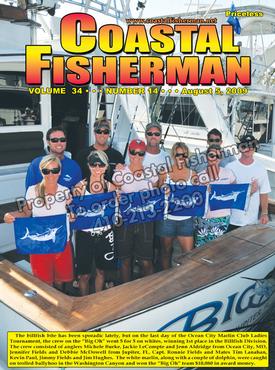


Article by Pat Schrawder
 Learning to Use Your Radar Controls
Learning to Use Your Radar Controls
Now that RADAR units are smaller, cheaper and less demanding of current, more and more boats are getting equipped with them. Like any piece of electronics, however, your effective use of them will depend on how much you understand their controls and how to apply them. Units will vary among manufacturers but they all have the same basic controls. Let’s take a look at them:
GAIN: Use this control to increase the target return on your screen. If you adjust it too high, you will “flood” the screen with unwanted objects. On the other hand, if you adjust it too low, you will miss all but the very largest objects.
RANGE: Use this to select how far out you want to see. The best all around range is 6 miles when you are fishing or cruising and lower, down to 1/8 mile, when you are approaching the Inlet. You can use the upper ranges to look for storms.
BRILLIANCE: This one is a matter of personal preference. Generally, you will use fairly high brilliance but you may want to cut it down some when it is night or a very cloudy day.
EBL: This stands for “Electronic Bearing Line” and is a dotted line that starts at the center and extends out to the edge of the screen. You can move this line around to wherever you want it to be and it will read out the bearing of the line from your boat. This can be used to give you a bearing to follow to get to a point or to just determine exactly where an object is relative to your boat.
VRM: Similar to the EBL, the VRM (Variable Range Marker) is a circle that can be moved from the center outward to the display screen edge. You control the movement and wherever it stops, you will see the exact distance that is away from your boat. The EBL and VRM are often used together to determine exactly how far away and at what bearing an object is from you.
FTC: (Fast Time Constant) is a control that is used to eliminate unwanted targets often caused by heavy rain. Turn this control off unless you have heavy rain, as it will reduce targets.
STC: (Often referred to as Sea Clutter) is a control similar to FTC except that it knocks down returns from high seas and wave caps. As with FTC, do not turn this on unless you need to do so.
TARGET STRETCH: This control is used to exaggerate or magnify the return on your screen so that very small targets such as small boats do not get overlooked.
ECHO TRAIL: Called other names by different manufacturers, this is a control that places a trail behind the targets letting you know what direction they are traveling.
ALARM OR GUARD: This feature is used to set an alarm zone around your boat so that, even if you are not watching the screen at all times, you will be notified by an audible tone when a target moves into the zone area that you have selected.
ST BY/ TX: These mean “Stand By” and “Transmit”. Your radar needs to be in TX before any images will show. However, you can save money if you do not leave your radar in TX position all the times. For every hour that your radar is in TX, it is firing the magnetron of the set. These magnetrons have a finite number of firing hours and then they will have to be replaced. The cost of replacement can be $350 or more.
Keeping your radar on and in TX at the dock is also a bad habit. If two sets that are close to each other happen to fire from one set into the other, they can damage the set.
There is one other item about radar that you need to keep in mind and that has nothing to do with controls. It is the “heading flash” that shows as a line or flash that goes from your boat to the outside edge of the screen and appears at the very top. It is supposed to represent the bow of your boat and its heading. It must be adjusted at the time of installation to reflect the position of your bow. Failure to do so could result in your hitting a target that you think you are going to narrowly miss.
Try some of these controls if you haven’t already. Take them one at a time until you are familiar with them. Hopefully, you will get more enjoyment and use from your radar unit as a result.
Also use your set in the beginning during days with good visibility so that you can correlate what you see by eye to what you see on the radar screen. That way, the first time you have little or no visibility, you will be able to look at your radar display with confidence and see familiar objects.
Pat Schrawder and her husband Larry are owners of L&L Marine Electronics on Golf Course Road in West Ocean City.